#Friedrich Saalfeld
Text

Heinrich Heine on Napoleon’s enemies
Buch Le Grand, Heinrich Heine, 1826
#Buch Le Grand of the Reisebilder of Heinrich Heine#Heinrich Heine#Heine#napoleon#napoleonic era#napoleon bonaparte#Louis XVIII#first french empire#french empire#londonderry#Friedrich Saalfeld#Friedrich Saalfeld (1785-1834)#19th century#history#Castlereagh#napoleonic#Robert Stewart#Göttingen#1820s#1826#literature#german literature#Buch Le Grand#restoration#restoration europe
18 notes
·
View notes
Text
Preußisch Blau und Lutherisch Schwarz - oder Leutnant Heinrich und Generalsuperintendent Josias Folge 5
Folge 5: Willkommen in der Residenz
Es ist Anfang November – später Herbst – geworden, wir müssen schon in unserem Dachkämmerchen die Heizung voll aufdrehen. Edda war es gelungen, mir die Zusage abzuringen – trotz starker Brandschutzbedenken –, einige echte Kerzen aufzustellen, so dass eine freundlichere Arbeitsatmosphäre entstanden war.
Aus den unterschiedlichsten Belegstellen der Dokumente…

View On WordPress
0 notes
Photo

Emilio Piani (German, 1817-1862)
Sugar plantation in Cuba, 1839
Museo Nacional De Bellas Artes de Cuba, Salon of Colonial art
In this scene Emilio Piani, observer, depicts a sugar plantation (un ingenio) in Cuba. Overseers are resting under the shade of an umbrella (held by a laborer) and are on horseback, while slaves or laborers are seen working the landscape to the right and center. Emilio takes careful detail of the tropical landscape, with its palm trees and rolling mountains.
Ludwig Friedrich Emil Piani (Emilio Piani) (1817-1862) – a portrait and landscape German painter born in Coburg, duchy of Saxe-Coburg-Saalfeld, Germany. As child he was a playmate of the Prince Albert, the future husband of Victoria, the Queen of the United Kingdom of Great Britain. In 1837 Emil Piani made a trip to the United States and then to Cuba residing in the later approximately till 1846. In 1841 his studio was on Obispo Street, Havana, probably where today is the Florida Hotel. During his stay in Cuba made several trips to nearby countries like Jamaica. In both islands he painted several portraits of notable persons and landscapes. In 1852 he returned to Coburg and after few years came back again to the Caribbean. He died in Curaçao in 1862.
#emilio piani#art#spanish#german#german art#cuba#classical art#landscape art#tropical art#black history month#germany#colonial art#colonies#sugar plantation#world history#traditional art#oil painting#cuban art#fine arts#the spanish#the german#caribbean#caribbean art#caribbean colonies#historical art
51 notes
·
View notes
Text
when: royally fun facts
They may not be fun, but some of them are made-up. Made up facts are in italics.
Grand Duchess Anastasia Mikhailovna of Russia
(Karolina Augusta's great-great-grandmother)
Is the granddaughter of Tsar Nicholas I of Russia
Is the mother of Alexandrine, Queen Consort of Denmark
Is the mother of Frederick Francis IV, Grand Duke of Mecklenburg-Schwerin
Is the mother of Cecilie, Crown Princess of Germany
Following the death of her husband, had a illegitimate son with her personal secretary
Three of her brothers were murdered by the Bolsheviks during the Russian revolution
Princess Karola of Urach
(Karolina Augusta's great-grandmother)
Karola’s father, Wilhelm Karl, 2nd Duke of Urach, was briefly elected as the King of Lithuania in 1918.
Princess Karola of Urach was the first queen consort of Mecklenburg, and also the last Grand Duchess of Mecklenburg-Schwerin and of Mecklenburg-Strelitz.
Karola was the grand-niece of Empress Elisabeth ‘Sisi’ of Austria.
Karola was the half-niece of Queen Elisabeth of the Belgians.
Karola half-first cousins include Leopold III of Belgium, and Marie José, the last Queen Consort of Italy.
Karola and Mary of Teck, Queen of the United Kingdom, both descend from morganatic branches of the House of Württemberg. Karola and Mary were third cousins as great-great-granddaughters of Friedrich II Eugene, Duke of Württemberg.
Karola was a Roman Catholic and retained her faith following her marriage to Heinrich Ludwig, though their children were brought up in the Evangelical Lutheran Church of Mecklenburg.
Duchess Thyra of Mecklenburg-Schwerin
(Karolina Augusta's grandmother)
Thyra’s father, Grand Duke Friedrich Franz IV of Mecklenburg-Schwerin, was overthrown by her father-in-law, King Heinrich Ludwig of Mecklenburg
Thyra was the first Crown Princess of Mecklenburg (1939 - 1954)
Thyra was the second Queen of Mecklenburg (1954 - 1980)
Thyra was the niece of Alexandrine, Queen of Denmark (1912 - 1947)
Thyra was the first cousin of Frederik IX of Denmark (1947 - 1972)
Thyra was the niece of Cecilie, Crown Princess of Germany (1905 - 1951)
Thyra was the first cousin of Louis Ferdinand, Prince of Prussia (1951 - 1994)
Thyra was the niece of Marie Louise, Margravine of Baden (1928 - 1929)
Thyra was the first cousin of Berthold, Margrave of Baden (1929 - 1963), who married Princess Theodora of Greece and Denmark (the older sister of Prince Philip, Duke of Edinburgh)
Thyra was the niece of Ernest Augustus, Duke of Brunswick (1913 - 1918) and head of the House of Hannover (1923 - 1953)
Thyra was the first cousin of Ernst August, Hereditary Prince of Brunswick, Prince of Hanover (1953 - 1987)
Thyra was the first cousin of Frederica, Queen of Greece (1947 - 1964)
Princess Eleonora of Leiningen
(Karolina Augusta's mother)
Descends from all three children of Victoria of Saxe-Coburg-Saalfeld: Carl, 3rd Prince of Leiningen; Princess Feodora of Leiningen; and Queen Victoria of the United Kingdom.
Queen Karolina Augusta I of Mecklenburg
Is the first female ruler in Mecklenburg’s 900 year history.
Will be the final ruler from the House of Mecklenburg which will eventually bring an end to the House’s status as the longest still reigning house in European history.
Is descended from both Queen Victoria of the United Kingdom, and of King Christian IX of Denmark.
Has been the youngest monarch in the world since 1992.
Has 15 godparents:
HRH Princess Cecilie Auguste, Duchess of Ludwigslust (paternal aunt)
HRH Princess Marie Anastasia, Duchess of Grevesmühlen (paternal aunt)
HRH Princess Benedikte of Denmark (paternal second cousin once removed)
HRH Princess Alexandra of Hanover, Princess of Leiningen (maternal aunt-by-marriage)
HSH Princess Margarita of Hohenlohe-Oehringen, Princess of Leiningen (maternal aunt-by-marriage)
HM Silvia, Queen of Sweden (family friend)
HM Queen Beatrix of the Netherlands (paternal and maternal second cousin twice removed)
HRH Princess Astrid of Belgium, Archduchess of Austria-Este (paternal third cousin once removed)
HRH Prince Charles, Prince of Wales (paternal third cousin once removed and family friend)
HRH Prince Frederik, Crown Prince of Denmark (paternal third cousin)
HH Prince Harald of Denmark (paternal first cousin once removed)
HSH Prince Hermann Friedrich of Leiningen (maternal first cousin once removed)
HRH Prince Felipe, Prince of Asturias (paternal third cousin)
HH Borwin, Duke of Mecklenburg-Strelitz (distant cousin and family friend)
HSH Hans-Adam II of Liechtenstein (distant cousin and family friend)
0 notes
Text
XXXII. Heinrich'in manastırları kapatıp okul derslerini iyileştirerek memlekette başlattığı reform hareketlerini geliştirmek konusundaki sabırlı ve kararlı tavrı hâlâ övgüyle anılır. Din adına haklarında soruşturma açılan bir çok Protestan vaizi himayesi altına alıp desteklemiştir. Bunların arasında herkesin bildiği Saalfeld rahibi Caspar Aquila adında biri de vardı. Bu adam, genç yaşında imparatorun ordusunda ordu vaizi olarak Hollanda'ya kadar gitmişti. Orada bir top mermisini kutsamayı reddettiği için, gemi azıya almış askerler tarafından bir havan topuna sokulup ateş edilecekken kaderi yüzüne gülmüş ve barut ateş almamış.
Ihlamurlar Altında Gezinti, Friedrich Schiller
0 notes
Text
Victoria I (Queen of UK of Great Britain and Ireland) (24 May 1819 – 22 January 1901)
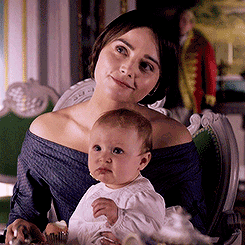

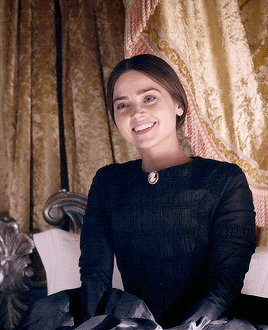


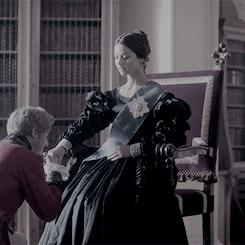

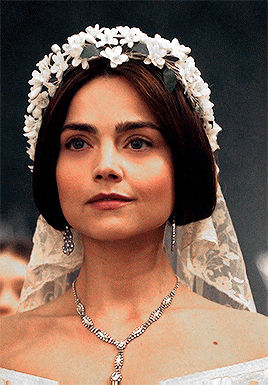


Daughter of Prince Edward (Duke of Kent and Strathearn) and Princess Victoria of Saxe-Coburg-Saalfeld.
Wife of Prince Albert of Saxe-Coburg and Gotha
Mother of Victoria (Princess Royal), Edward VII, Princess Alice, Prince Alfed (Duke of Saxe-Coburg and Gotha), Princess Louise, Princess Helena, Prince Arthur (Duke of Connaught and Strathearn), Prince Leopold (Duke of Albany), and Princess Beatrice.
Grandmother of Wilhelmina II (King of Germany and Prussia), Princess Charlotte of Prussia, Prince Henry of Prussia, Prince Sigismund of Prussia, Princess Viktoria of Prussia, Prince Waldemar of Prussia, Princess Sophia of Prussia, Princess Margaret of Prussia, Prince Albert Victor (Duke of Clarence and Avondale), George V, Louise (Princess Royal), Princess Victoria, Princess Maud of Wales, Prince Alexander John of Wales, Princess Victoria of Hesse and by Rhine, Elizabeth Feodorovna (Grand Duchess of Russia), Princess Henry of Prussia, Ernest Louis (Grand Duke of Hesse), Prince Friedrich of Hesse and by Rhine), Alexandra Feodorovna (Empress of Russia), Princess Marie of Hesse and by Rhine, Alfred (Hereditary Prince of Saxe-Coburg and Gotha), Marie of Romania, Victoria Feodorovna (Grand Duchess of Russia) Princess Alexandra of Saxe-Coburg and Gotha (Princess Consort of Hohenlohe-Langenburg), Princess Beatrice of Saxe-Coburg and Gotha (Duchess of Galliera), Prince Christian Victor of Schleswig-Holstein, Albert (Duke of Schleswig-Holstein), Princess Helena Victoria of Schleswig-Holstein, Princess Marie Louise of Schleswig-Holstein (Princess Aribert of Anhalt), Prince Harald, Princess Margaret of Connaught (Crown Princess of Sweden), Prince Arthur of Connaught, Princess Patricia of Connaught (Lady Patricia Ramsay), Princess Alice (Countess of Athlone), Charles Edward (Duke of Saxe-Coburg and Gotha), Alexander Mountbatten (1st Marquess of Carisbrooke), Victoria Eugenie of Battenberg (Queen of Spain), Lord Leopold Mountbatten, and Prince Maurice of Battenberg
Mother-in-law of Fredrick III (Emperor of Germany), Princess Alexandra of Denmark, Louis IV (Grand Duke of Hesse and by Rhine), Grand Duchess Maria Alexandrovna of Russia, Prince Christian of Schleswig-Holstein, John Campbell (9th Duke of Argyll), Princess Louise Margaret of Prussia, Princess Helena of Waldeck and Pyrmont, and Prince Henry of Battenberg.
19 notes
·
View notes
Text
The Campaign of Prussia
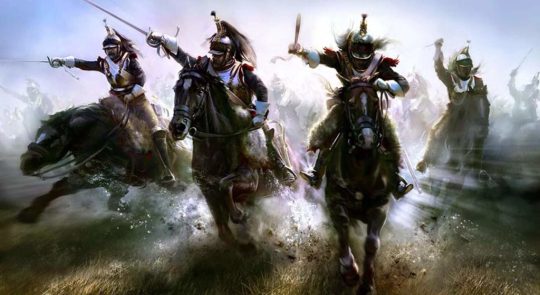
Prussia was not prepared for the type of war that Napoleon unleashed. Despite being a member of a new coalition (Britain, Prussia, Sweden, Saxony, and Russia), Prussia was in a weak position strategically and politically. The decision to declare war was not done in concert with Emperor Alexander, with whom the king concluded a secret agreement of support in the event of an attack by France, and consequently no Russian troops were readily available to support Prussia. Britain's financial subsidies were certainly welcome but could not replace actual boots on the ground. Sweden's involvement produced few tangible benefits. The indigence of Prussia's foreign policy was equalled only by the ineptitude of its military high command. The Prussian army enjoyed a reputation far in excess of its actual merits. Long gone were the glory days of Frederick the Great. The Prussian military of 1806 was much inferior to the army that was responsible for the brilliant success of the 1740s and 1750s. While the Prussian soldiers continued to display admirable courage, their aging superiors failed to fully account for changes that had taken place in the art of war during the Revolutionary Wars. In the words of a Prussian observer, they demonstrated not just "a style of fighting which had outlived its usefulness but the most extreme poverty of the imagination to which routine has ever led." On the eve of its war with France, Prussia could rely only on its own forces and on small contingents from Hesse and Saxony, the latter being rather reluctant to fight on behalf of their northern neighbor. The main part of the Prussian forces, around 65,000 men, was commanded by Charles William Ferdinand, Duke of Brunswick, while Friedrich Ludwig Fürst Hohenlohe-Ingelfingen took charge of a Prusso-Saxon corps of around 45,000 men; another 34,000 men were left to protect Westphalia and Hesse, and 18,000 West Prussians were kept in reserve.
Napoleon was better prepared for the war. He commanded a well-honed army that had been fully trained in the camps of Boulogne and tested on the battlefields of 1805. The Grande Armée, which had not returned to France following the last campaign but instead remained quartered in southern Germany, had some 180,000 men on the river Main, determined to strike at Berlin before help could arrive from Russia. On October 6 the French invaded Saxony and, taking advantage of the Prussian failure to block passage through the Thüringian Forest, scored a first victory at Saalfeld (October 10) where Marshal Jean Lannes routed an exposed Prussian-Saxon corps under Prince Louis Ferdinand of Prussia, who was killed in action. The defeat dazed the Prussian commanders, who decided to fall back to the Elbe and Berlin. It was too late. Four days later, on October 14, Napoleon caught up with them. Assuming that the main Prussian army was at Jena, the French emperor divided his forces, sending Marshal Louis Nicolas Davout with the III Corps some ten miles north to strike the enemy's rear. When the battle commenced at Jena, Napoleon was able to quickly concentrate some 95,000 men against just 38,000 Prussians commanded by Frederick Louis, Prince of Hohenlohe-Ingelfingen. The Prussian commander hoped to have the support of another 15,000 men deployed about ten miles away at Weimar, but they arrived only in the afternoon, when the outcome of the battle was no longer in doubt. The Prussians fought valiantly but were no match for the French troops, superbly commanded by Napoleon and his marshals. By afternoon the Prussians were already in a retreat that soon turned into a rout.


While Napoleon smashed what he believed was the main Prussian army at Jena, Davout's III Corps of just 28,000 men stumbled across the bulk of the enemy forces at Auerstädt, where Brunswick had concentrated more than 60,000 men with 230 cannons. Realizing the danger he was facing, the French "Iron Marshal" exploited the terrain of the Saale Valley- hilly, with deep ravines cutting into the various plateaus- to fight a resolute action. He formed his divisions into huge squares whenever the Prussian cavalry charged, and he demonstrated an ability to coordinate the actions of his infantry, artillery and cavalry. Despite losing a quarter of its men, the French corps not only held its ground but seized the initiative and pushed forward, threatening to envelop the Prussian flanks. The death of the Prussian commander in chief, Brunswick, disheartened the Prussian army, which began to break up even though its reserves had not yet been committed. A disorderly retreat degenerated into chaos when the fleeing masses of Brunswick's forces crossed paths with the Prussian survivors from Jena, whom Hohenlohe was leading into Pomerania.
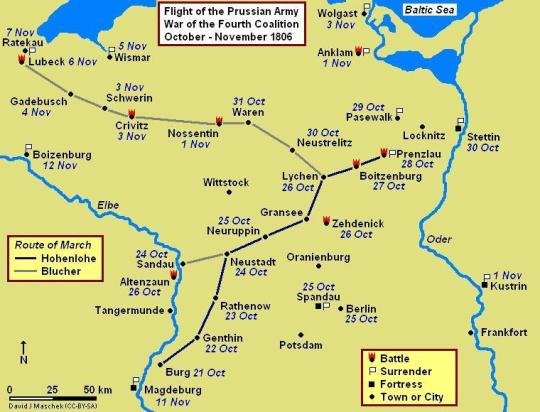
The destruction of the Prussian forces in the twin battles of Jena and Auerstädt caused profound demoralization in Prussia. And, in what became one of the most thorough and rapid pursuits in history, French forces scattered across the Prussian kingdom, capturing cities, fortresses, and thousands of prisoners. The great Prussian fortresses of Spandau, Stettin, Küstrin, and Magdeburg, with garrisons counting thousands of men, could have checked the French advance and gained precious time for the army to reorganize. Instead they capitulated without so much as firing a shot, effectively breaking Prussia's military backbone. Some detachments of Prussian forces held out for another month before capitulating one by one. Hohenlohe's 14,000 men surrendered to Marshal Joachim Murat at Prenzlau on October 28. Murat then joined Soult and Bernadotte in pursuit of some 12,000 Prussians who had shown much spirit under the fiery Gebhard Lebrecht Blücher von Wahlstatt as they retreated to the Hanseatic port of Lübeck, hoping to unite with a Swedish army that was reported to be here. But upon arriving on November 5, Blücher found that the Swedes had landed only a small brigade of fewer than 2,000 men. The following day, the French forces stormed and sacked Lübeck, forcing Blücher to capitulate; the Prussian general's last stand quickly entered Prussian lore, turning him into a symbol of heroism and steadfast resistance for the defeated nation. However, in just one month Prussia had been effectively knocked out of the war, apart from a force under General Anton William Lestocq, which moved east to link up with the Russians, and another under General Friedrich Adolf Graf von Kalkreuth, which was besieged in Danzig.
On October 25, because of its valiant performance at Auerstädt, Davout's III Corps was given the honor of being the first to enter the Prussian capital, Berlin, followed a day later by Napoleon, who visited the tomb of Frederick the Great and supposedly stood in silence for a minute before remarking, "If you were still alive, I would not be standing here."
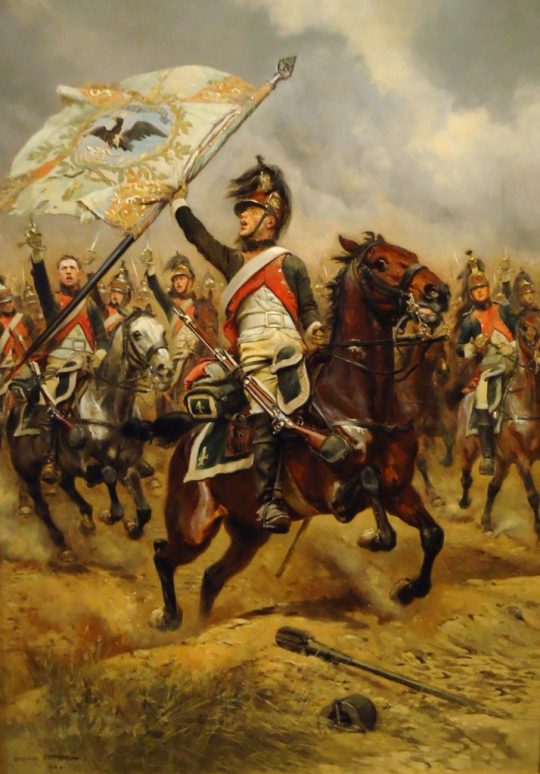
The Franco-Prussian war was brief, lasting just four weeks, but the military and political collapse of Prussia had enormous ramifications. In contrast to his victory over Austria in 1805, Napoleon insisted on organizing a victory parade in Berlin, where the prisoners from the Noble Guard, who just weeks before had sharpened their swords on the French embassy's steps, were prominently featured. The war not only destroyed Prussia's martial reputation but ended the country's claims to the status of a great power.
Alexander Mikaberidze- The Napoleonic Wars, A Global History
#napoleonic#alexander mikaberidze#the napoleonic wars: a global history#napoléon bonaparte#campaign of prussia poland#battle of saalfeld#battle of iéna#battle of auerstaedt#jean lannes#louis nicolas davout#joachim murat#nicolas jean de dieu soult#jean baptiste bernadotte#blücher
32 notes
·
View notes
Text
ANTOINETTE
Princess of Saxe-Coburg-Saalfeld
(born 1779 - died 1824)

pictured above is a portrait of the Princess of Saxe-Coburg-Saalfeld, a copy by Herbert Smith from 1884, of a pastel by Johann Heinrich Schröder from c. 1795
-------------------- ~ -------------------- ~ --------------------
SERIES - On this day August Edition: Antoinette was born on 28 August 1779.
-------------------- ~ -------------------- ~ --------------------
ANTOINETTE ERNESTINE AMALIE was born on 28 August 1779, in Coburg. She was the second child of Franz, Duke of Saxe-Coburg-Saalfeld and his second wife Countess Auguste Reuss of Ebersdorf.
Born a member of the Saxe-Coburg-Saalfeld line of the Ernestine branch of the HOUSE OF WETTIN, she was a PRINCESS OF SAXE-COBURG-SAALFELD from birth.
On her youth she traveled to Russia with her mother and sisters Princess Sophie and Princess Juliane, in order to be inspected as suitable brides for Grand Duke Konstantin Pavlovich of Russia, a grandson of Yekaterina II (the Great), Empress of all the Russias. However her sister Princess Juliane was chosen by the Empress and was baptized in the Orthodox Church, changing her name to Anna Fyodorovna.
In 1798 she married ALEXANDER FRIEDRICH KARL, a Duke of Württemberg and they had five children (check the list below). He was one of the youngest sons of Friedrich Eugen II, Duke of Württemberg and Princess Friederike of Brandenburg-Schwedt. And after her wedding she became known by his title as DUCHESS ALEXANDER OF WÜRTTEMBERG.
After 1800 she moved with her family to Russia where her husband joined the Imperial Army under the service of his brother in-law Pavel I, Emperor of all the Russias, the husband of his sister Mariya Fyodorovna (born Duchess Sophie Dorothee of Württemberg).
Another of her sisters Princess Victoire married into the British Royal Family, having given birth to Princess Alexandrina Victoria of Kent in 1819.
As she was related to the Imperial Family through her sister and sister-in-law she was actively present at the Russian Court and the life of the Imperial Family. And when her sister separated from Grand Duke Konstantin in 1820 it is said that she sided with her brother-in-law.
The Duchess Alexander of Württemberg died in Saint Petersburg aged 44, in 1824, after being ill for two weeks.
-------------------- ~ -------------------- ~ --------------------
ANTOINETTE and her husband ALEXANDER had five children...
Duchess Marie of Württemberg - wife of Ernst I, Duke of Saxe-Coburg and Gotha;
Duke Paul of Württemberg - died aged one;
Duke Alexander of Württemberg - husband of Princess Marie of Orléans;
Duke Ernst of Württemberg - husband of Natalie Eschborn; and
Duke Friedrich of Württemberg - died aged four.
-------------------- ~ -------------------- ~ --------------------
Two years after her death, her brother (and future son-in-law) Ernst III, Duke of Saxe-Coburg-Saalfeld exchanged the Duchy of Saalfeld for the Duchy of Gotha, becoming Ernst I, Duke of Saxe-Coburg and Gotha and founding another Ernestine branch, the House of Saxe-Coburg and Gotha.
Her niece Princess Alexandrina Victoria succeeded as Victoria, Queen of the United Kingdom in 1837 and in 1840 married another of her nephews Prince Albert of Saxe-Coburg and Gotha, one of the sons of ther brother Duke Ernest I.
By 1903 her grandson Duke Philipp of Württemberg became the heir presumptive of the Kingdom of Württemberg, however as the Monarchy was abolished after World War I he never ascended to the throne.
#antoinette of saxe coburg saalfeld#princess of saxe coburg saalfeld#saxe coburg saalfeld#house of saxe coburg saalfeld#german nobility#royals#royalty#monarchy#monarchies#royal history#german history#european history#world history#history#history lover#18th century#19th century#catherine the great#romanov#maria feodorovna#tsar paul i#history by laura
5 notes
·
View notes
Photo
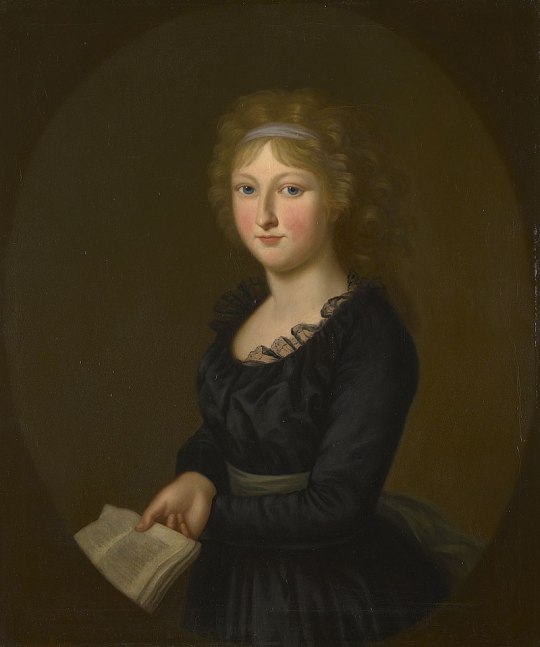
Princess Antoinette of Saxe-Coburg-Saalfeld (28 August 1779 – 14 March 1824) was a German princess of the House of Wettin. By marriage, she was a Duchess of Württemberg. Through her eldest surviving son, she is the ancestress of today's (Catholic) House of Württemberg.
Born in Coburg, she was the second daughter of Francis, Duke of Saxe-Coburg-Saalfeld and Countess Augusta Reuss-Ebersdorf. She was also the elder sister of King Leopold I of Belgium and the aunt of both Queen Victoria and her husband, Prince Albert. Her maternal grandparents were Heinrich XXIV, Count Reuß-Ebersdorf and Karoline Ernestine von Erbach-Schönberg, and her paternal grandparents were Ernst Friedrich and Antoinette of Braunschweig-Wolfenbüttel.
#Antoinette of Saxe-Coburg-Saalfeld#House Saxe-Coburg-Saalfeld#XVIII century#XIX century#people#portrait#paintings#art#arte
4 notes
·
View notes
Photo










House of Coburg & of Württemberg: Princess Antoinette of Saxe-Coburg-Saalfeld
Antoinette was born as the second child and daughter to Duke Franz of Saxe-Coburg-Saalfeld and his wife Countess Auguste Reuß of Ebersdorf. Her siblings include Countess Sophie of Mensdorff-Pouilly, Grand Duchess Anna Feodorovna of Russia, Duke Ernst I of Saxe-Coburg and Gotha, Duke Ferdinand of Saxe-Coburg-Saalfeld-Koháry, Duchess Victoria of Kent and Strathearn and Belgian King Leopold I. Through them, she was an aunt to many important European royals of the 19th century, for example Queen Victoria and her husband Prince Albert, Belgian King Leopold II and his sister Empress Carlota of Mexico, Duke Ernst II of Saxe-Coburg and Gotha, King Fernando II of Portugal, Duchess Victoria of Nemours and Princess Feodora of Leiningen.
On November 17th, 1798, the 19-year-old Antoinette married the 27-year-old Prince Alexander of Württemberg. The couple moved to Russia where her husband served in the army. Due to Russian customs, Alexander was referred to as Duke here and Antoinette as Duchess. Their children would receive the same titles. The couple had five children: Four sons and a daughter. While their two surviving sons Alexander and Ernst entered the Russian army, Marie married her uncle Duke Ernst I of Saxe-Coburg and Gotha and thereby became the stepmother of Prince Albert, Queen Victoria’s husband and cousin.
Antoinette might have had an affair and an illegitimate child, according to a correspondence between Queen Luise of Prussia and her brother Grand Duke Georg of Mecklenburg-Strelitz. According to their letters from 1802, Antoinette and Alexander had not spoken to each other in two years and yet Antoinette was with child. They allegedly knew about it from The Duke of Weimar who said that the father of this child was a the Canon Mister of Höbel. Whether that is true or just gossip is uncertain.
Antoinette’s husband became governor of Belarus in 1811. Antoinette herself received the Grand Cross of the Imperial Russian order of Saint Catherine. She was viewed as an influential person at Russian court since her sister-in-law was Empress Marie Feodorovna and her younger sister Juliane was married to the Emperor’s younger brother Konstantin.
Antoinette died at only 44 years of age. She is buried at Friedenstein Castle in Gotha alongside her sons Paul and Friedrich. Through her oldest son Alexander, she is the ancestress of the modern Catholic House of Württemberg.
// Luise Bähr in Luise - Königin der Herzen (2010)
#historyedit#German history#Russian history#Victorian Era#women in history#historic women#European history#19th century#1800s#House of Coburg#House of Wettin#House of Württemberg#Princess Antoinette of Saxe-Coburg-Saalfeld#Duchess Antoinette of Württemberg
77 notes
·
View notes
Text
Queen Victoria’s daughters
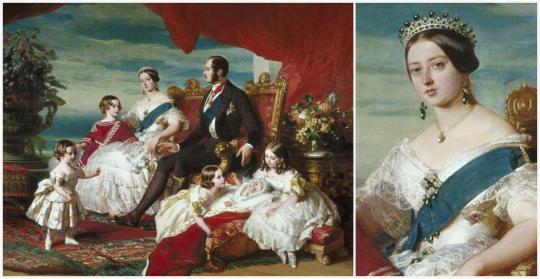
Princess Victoria Adelaide
(future German Empress and Queen of Prussia)
born – November 21, 1840 at Buckingham Palace in London

Princess Victoria was the first child and eldest daughter of Queen Victoria and her husband, Prince Albert. She was christened in the Throne Room of Buckingham Palace and she is named in honor of both her mother, Queen Victoria and her maternal grandmother, Princess Victoria of Saxe-Coburg-Saalfeld.
Victoria was the heiress presumptive (the person entitled to inherit a throne but whose position can be displaced by the birth of an heir apparent) until her brother, Prince Albert Edward, was born the next year. At that time, the Queen gave Victoria the title of HRH the Princess Royal, a grand name for a one year old but the family called her “Vicky”.
For the special occasion of the birth of her first child, the Queen commissioned a special silver baptismal font made by Barnard & Co. decorated with the symbol of the lily to represent purity and new life.
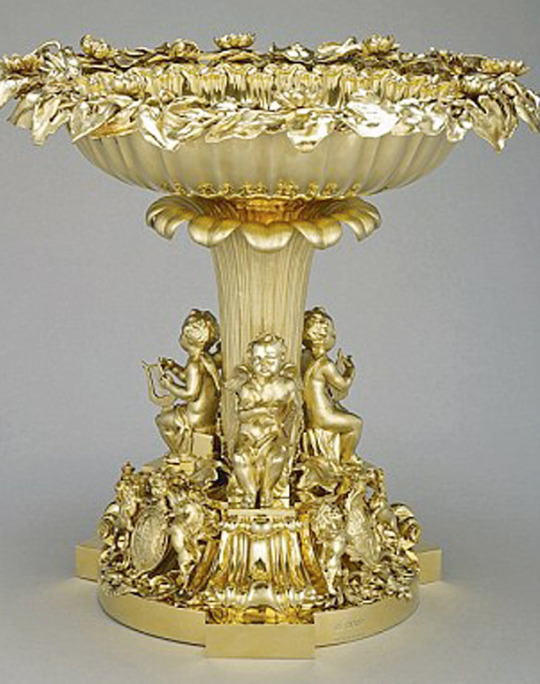
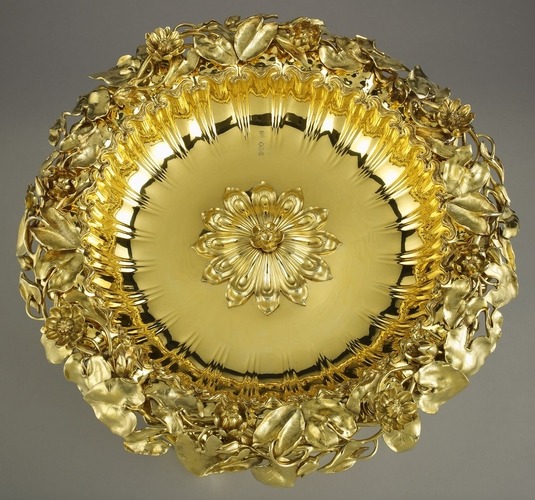
The Queen Victoria also commissioned a lovely christening gown made with Honiton lace and lined in white satin, it has a very long skirt with an elaborate collar and bow.
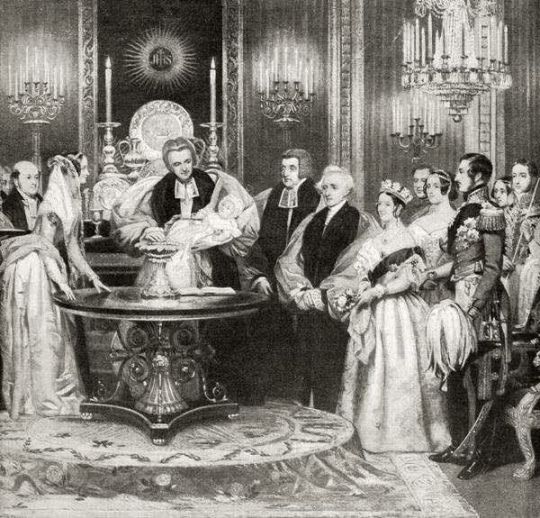
Since 1841 over 60 royal children have worn the gown for their christenings including four Kings, King Edward VII, King George V, King Edward VIII, King George VI and Queen Elizabeth II.
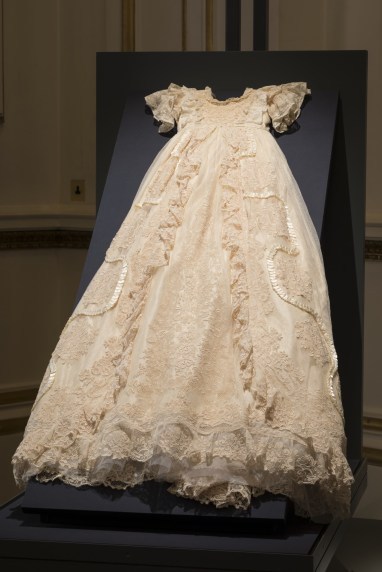
The original robe was very old and fragile so in 2008, to preserve the historical garment, an exact replica was made by the Queen’s dresser, Angela Kelly. Most recently the replicated christening gown has been worn by Prince George in 2013, by Princess Charlotte in 2015, and by Prince Louis in 2018
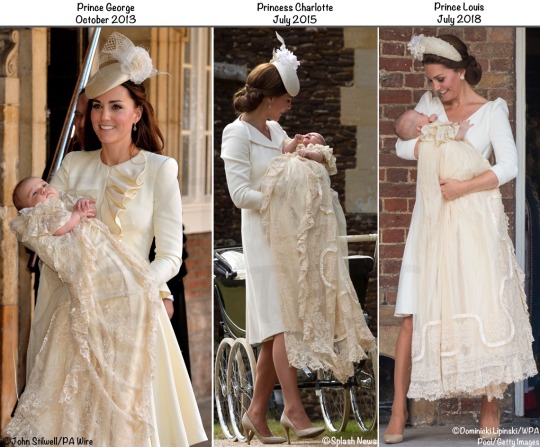
Since the Queen controlled all aspects of her children’s personal lives, by the time Victoria was 10 years old it was arranged that would met her future husband at the Great Exhibition of 1851. He was Prince Frederick William of Prussia and he was second in line to inherit the Prussian throne, this alliance was a calculated move in which the Queen hoped to strengthen the political connections between the two countries.
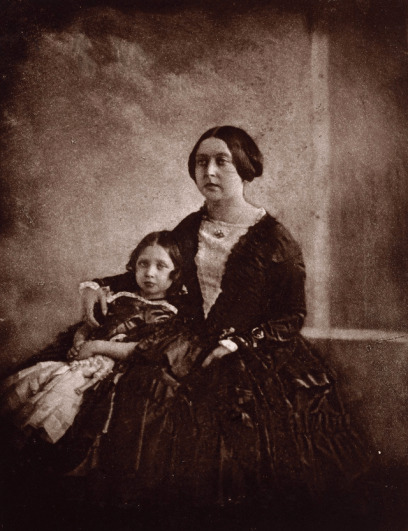
Queen Victoria with her eldest daughter Victoria, Princess Royal circa 1845
By 1955, Victoria and Frederick were engaged but the public announcement was delayed for a few years because Victoria was only fourteen years old and Frederick was twenty-four. Finally, after a long wait, their engagement was officially announced in 1857.
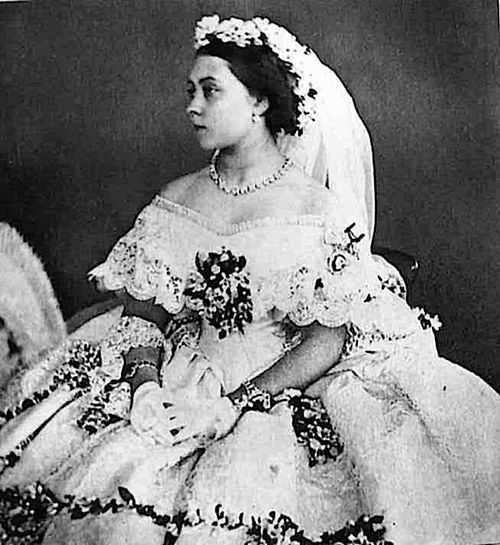
At the insistence of the Queen, the wedding of Victoria and Frederick took place in England on January 25, 1858 at the Chapel Royal at St. James Palace in London.
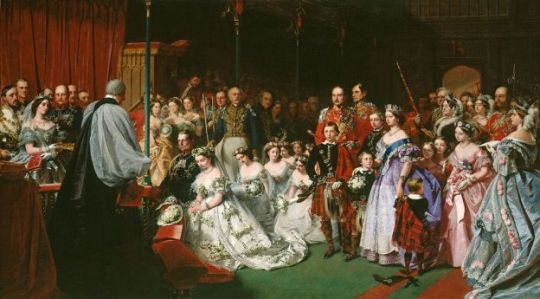
Wedding of Victoria, Princess Royal and Prince Friedrich of Prussia
In 1861, Frederick’s father became King William I of Prussia, Frederick and Victoria were now the Crown Prince and Crown Princess. The couple went on to have a very happy marriage based on true love and mutual respect; they had eight children – Wilhelm (the future German Emperor), Charlotte, Henry, Sigmund, Viktoria, Waldemar, Sophia and Margaret.

With the death of Frederick’s father in 1888, he became the Emperor Frederick III and Victoria became the Empress of Prussia, their son was now Crown Prince Wilhelm.

Frederick III, Emperor of Germany and King of Prussia; Victoria, Empress of Germany and Queen of Prussia by Hills & Saunders, albumen carte-de-visite, circa 1870, NPG Ax132839 © National Portrait Gallery, London
Unfortunately, Frederick was already terminally ill with throat cancer at the time of his ascension and died after only 99 days on the throne, his son was now the Emperor. Guided by Bismarck, one of the first things that Wilhelm did was to immediately banish the widowed Victoria to live at the Castle Friedrichshof located in the hills near Frankfurt. By this time, Victoria had lost her father in 1861 and following the example of her mother’s intense mourning, after the death of her own husband she dressed in black for the rest of her life.

The widowed Victoria built a satisfying life at Castle Friedrichshof and she continued her civic work in Berlin by establishing a training school for nurses and also as a patron of the arts helping to organize the 1872 Industrial Art Exhibition.

In 1899, while visiting her mother at Balmoral, Victoria was feeling ill and the British doctors soon determined a diagnose of breast cancer.

Sadly, upon her return to Germany later 1900, the cancer had spread to her spine and she died on August 5, 1901 at Castle Friedrichshof, she is buried in the royal mausoleum at the Friedenskircheat Postdam.j
Wonderful! Thank you😁❤️❤️❤️❤️❤️❤️
19 notes
·
View notes
Photo

#OnThisDay 1st 📸 - Year 1494, Birth of Francis I of France. was King of France from 1515 until his death in 1547. He was the son of Charles, Count of Angoulême, and Louise of Savoy. He succeeded his first cousin once removed and father in-law Louis XII, who died without a son. Francis of Orléans was born on 12 September 1494 at the Château de Cognac in the town of Cognac, which at that time lay in the province of Saintonge, a part of the Duchy of Aquitaine. Today the town lies in the department of Charente. Francis was the only son of Charles of Orléans, Count of Angoulême and Louise of Savoy, and a great-great-grandson of King Charles V of France. 2nd 📸 - Year 1804, Birth of Karl, Prince of Leiningen. the third Prince of Leiningen and maternal half-brother of Queen Victoria. Leiningen served as a Bavarian lieutenant general, before he briefly played an important role in German politics as the first Prime Minister of the Provisorische Zentralgewalt government formed by the Frankfurt Parliament in 1848. A member of the Hardenburg branch of the Leiningen family, Carl was born in Amorbach, the son of Prince Emich Carl of Leiningen (1763–1814) by his second marriage with Princess Victoria of Saxe-Coburg-Saalfeld (1786–1861). He was the only son, as Emich Carl's son by his first wife, Friedrich, had died in 1800. 3rd 📸 - Year 1837, Birth of Louis IV, Grand Duke of Hesse the Grand Duke of Hesse and by Rhine, reigning from 13 June 1877 until his death. Through his own and his children's marriages he was connected to the British Royal Family, to the Imperial House of Russia and to other reigning dynasties of Europe. Louis was born at the Prinz-Karl-Palais in Darmstadt, the capital of the Grand Duchy of Hesse and by Rhine in the German Confederation, the first son and child of Prince Charles of Hesse and by Rhine (23 April 1809 – 20 March 1877) and Princess Elisabeth of Prussia (18 June 1815 – 21 March 1885), granddaughter of King Frederick William II of Prussia. Prince Louis was from birth second-in-line to the grand ducal throne, after his father. #RoyalHistory #HistoryofRoyals #RoyalBirth https://www.instagram.com/p/CTtol2DPTIQ/?utm_medium=tumblr
0 notes
Photo

Vor dem Amtsgericht Eisenach hat am Donnerstag der Prozess gegen vier junge Männer aus der rechten Szene aus Eisenach begonnen. Ein Prozess von dem sich insbesondere politisch Engagierte Signalwirkung erhoffen.
Ezra: Straffreier Terror in Eisenach
"Die Angeklagten und ihr Umfeld terrorisieren weitgehend straffrei seit Jahren alle diejenigen, die bisher die Courage hatten, sich der rechten Normalität in Eisenach entgegenzustellen.“, erklärt Robert Friedrich, Mitarbeiter der Opferberatung ezra.
Zentrum rechter Gewalt in Thüringen
Nach Einschätzung der Opferberatungsorganisation habe sich Eisenachneben Saalfeld zu einem Zentrum rechter Gewalt in Thüringenentwickelt. Von 8 bis 18 Uhr kündigte ein Bündnis eine Kundgebung an, um auf die mutmaßlich bedrohlichen Zustände in Eisenach aufmerksam zu machen und Opfer von Gewalttaten zu unterstützen, wie es in einer Mitteilung der Opferberatung heißt.
https://www.thueringen24.de/thueringen/article216336191/Neonazi-Thueringen-Eisenach.html
0 notes
Text
who: royal degrees of separation
The imperial, royal, princely and noble families of Europe have been intermarrying for thousands of years. This practice continues to this day, though not as frequently as in times past.
Karolina Augusta I of Mecklenburg is related to all current reigning and most non-reigning houses in Europe. Due to continual intermarriage, she is related to several families through various bloodlines. The lineage connecting her to these houses will be documented here. This is not an exhaustive list.
The closest relation is listed first, followed by any other notable shared ancestors.
REIGNING HOUSES OF EUROPE
Belgium
Karolina Augusta I and Philippe of the Belgians are fourth cousins as descendants of King Christian IX of Denmark and his wife Louise of Hesse-Kassel.
Karolina Augusta and Elisabeth, Duchess of Brabant are fourth cousins once removed.
Karolina Augusta and Philippe are also descendants of Maximilian I Joseph of Bavaria and his second wife Caroline of Baden.
Denmark
Karolina Augusta I and Margrethe II are second cousins once removed as descendants of Friedrich Franz III of Mecklenburg-Schwerin and his wife Grand Duchess Anastasia Mikhailovna of Russia.
Karolina Augusta and Crown Prince Frederik are third cousins.
Karolina Augusta and Margrethe are also descendants of Queen Victoria of the United Kingdom, and of King Christian IX of Denmark.
Liechtenstein
Karolina Augusta I and Hans-Adam II are fourth cousins twice removed as descendants of Maximilian I Joseph of Bavaria and his second wife Caroline of Baden.
Karolina Augusta and Hereditary Prince Alois are fifth cousins once removed.
Luxembourg
Karolina Augusta I and Henri of Luxembourg are fourth cousins as descendants of King Christian IX of Denmark and his wife Louise of Hesse-Kassel.
Karolina Augusta and Hereditary Grand Duke Guillaume are fourth cousins once removed.
Karolina Augusta and Henri are also descendants of Maximilian I Joseph of Bavaria and his wife Caroline of Baden.
Monaco
Karolina Augusta I and Albert II are fifth cousins as descendants of Florestan I of Monaco and his wife Maria Caroline Gibert de Lametz.
Karolina Augusta and Hereditary Prince Jacques are fifth cousins once removed.
The Netherlands
Karolina Augusta I and Willem-Alexander are third cousins once removed as descendants of Friedrich Franz II of Mecklenburg-Schwerin and his third wife Marie of Schwarzburg-Rudolstadt.
Karolina Augusta and Catharina-Amalia, Princess of Orange, are fourth cousins.
Karolina Augusta and Willem-Alexander are also descendants of George Victor, Prince of Waldeck and Pyrmont and his first wife Princess Helene of Nassau.
Norway
Karolina Augusta I and Harald V of Norway are third cousins once removed as descendants of King Christian IX of Denmark and his wife Louise of Hesse-Kassel.
Karolina August and Crown Prince Haakon are fourth cousins.
Karolina Augusta and Harald are also descendants of Queen Victoria of the United Kingdom and her husband Albert of Saxe-Coburg and Gotha.
Spain
Karolina Augusta I and Felipe VI of Spain are third cousins as descendants of Ernst August, Crown Prince of Hanover and his wife Thyra of Denmark.
Karolina Augusta and Leonor, Princess of Asturias are third cousins once removed.
Karolina Augusta and Felipe are also descendants of Queen Victoria of the United Kingdom and her husband Albert of Saxe-Coburg and Gotha.
Sweden
Karolina Augusta I and Carl XVI Gustaf of Sweden are third cousins twice removed as descendants of Queen Victoria of the United Kingdom and her husband Albert of Saxe-Coburg and Gotha.
Karolina Augusta and Crown Princess Victoria are fourth cousins once removed.
Karolina Augusta and Carl XVI Gustaf are also descendants of George Victor, Prince of Waldeck and Pyrmont and his first wife Princess Helene of Nassau.
The United Kingdom
Karolina Augusta I and Elizabeth II of the United Kingdom are third cousins once removed as descendants of King Christian IX of Denmark and his wife Louise of Hesse-Kassel.
Karolina Augusta I and Prince Philip, Duke of Edinburgh are second cousins twice removed as descendants of King Christian IX of Denmark and his wife Louise of Hesse-Kassel.
Karolina Augusta I and Charles, Prince of Wales are third cousins once removed through his father’s descent of King Christian IX of Denmark and his wife Louise of Hesse-Kassel.
Karolina Augusta is fourth cousins to the grandchildren of Prince Philip, Duke of Edinburgh.
Karolina Augusta and Elizabeth, and her husband, are also descendants of Queen Victoria of the United Kingdom and her husband Albert of Saxe-Coburg and Gotha.
Karolina Augusta is also second cousins once removed to The Duke of Kent, Princess Alexandra of Kent, and Prince Michael of Kent as descendants of Grand Duke Vladimir Alexandrovich of Russia and his wife Duchess Marie of Mecklenburg-Schwerin.

NON-REIGNING HOUSES OF EUROPE
Austria-Hungary
Karolina Augusta I and Karl von Habsburg are fourth cousins once removed as descendants of King John of Saxony and his wife Amalie Auguste of Bavaria.
Karolina Augusta and Ferdinand Zvonimir are fifth cousins.
Karolina Augusta and Karl are also descendants of Ernst I, Prince of Hohenlohe-Langenburg and his wife Princess Feodora of Leiningen.
Baden (German Empire)
Karolina Augusta I and Max, Margrave of Baden second cousins once removed as descendants of Ernst August, Crown Prince of Hanover and his wife Thyra of Denmark.
Karolina Augusta I and Hereditary Prince Bernhard are third cousins.
Karolina Augusta I and Max are also descendants of Queen Victoria of the United Kingdom and her husband Albert of Saxe-Coburg and Gotha.
Bulgaria
Karolina Augusta I and Simeon II of Bulgaria are fourth cousins once removed as descendants of King John of Saxony and his wife Amalie Auguste of Bavaria.
Karolina Augusta and Boris, Prince of Turnovo are fifth cousins once removed.
Karolina Augusta and Simeon are also descendants of Francis, Duke of Saxe-Coburg-Saalfeld and his second wife Countess Augusta Reuss of Ebersdorf.
Greece
Karolina Augusta I and Constantine II of Greece are second cousins once removed as descendants of Ernst August, Crown Prince of Hanover and his wife Thyra of Denmark.
Karolina Augusta and Crown Prince Pavlos are third cousins.
Karolina Augusta and Constantine are also descendants of King Christian IX of Denmark, and of Queen Victoria of the United Kingdom.
Karolina Augusta and Crown Prince Pavlos are also descendants of Friedrich Franz III of Mecklenburg-Schwerin and his wife Grand Duchess Anastasia Mikhailovna of Russia.
Hannover (German Empire)
Karolina Augusta I and Ernst August V, Prince of Hannover are second cousins once removed as descendants of Ernst August, Crown Prince of Hannover and his wife Princess Thyra of Denmark.
Karolina Augusta and Ernst August, Hereditary Prince of Hannover are third cousins.
Karolina Augusta and Ernst August are also descendants of Queen Victoria of the United Kingdom and her husband Albert of Saxe-Coburg and Gotha.
Hesse (German Empire)
Karolina Augusta I and Donatus, Landgrave of Hesse are fourth cousins once removed as descendants of Queen Victoria of the United Kingdom and her husband Albert of Saxe-Coburg and Gotha.
Karolina Augusta I and Moritz, Hereditary Prince of Hesse are fifth cousins.
Hohenlohe-Langenburg (German Empire)
Karolina Augusta I and Philipp, Prince of Hohenlohe-Langenburg are third cousins once removed as descendants of Alfred, Duke of Saxe-Coburg and Gotha and his wife Grand Duchess Maria Alexandrovna of Russia.
Karolina Augusta and Hereditary Prince Max Leopold are fourth cousins.
Hohenzollern (German Empire)
Karolina Augusta I and Karl Friedrich, Prince of Hohenzollern are first cousins once removed as descendants of Karl, 6th Prince of Leiningen and his wife Grand Duchess Maria Kirillovna of Russia.
Karolina Augusta and Hereditary Prince Alexander are second cousins.
Leiningen (German Empire)
Karolina Augusta I is a niece of Andreas, 8th Prince of Leiningen.
Karolina Augusta I and Hereditary Prince Ferdinand are first cousins.
Mecklenburg-Strelitz (German Empire)
Karolina Augusta I and Borwin, Duke of Mecklenburg-Strelitz are fourth cousins once removed as descendants of John of Saxony and his wife Princess Amalia of Bavaria.
Karolina Augusta I and Hereditary Duke Alexander are fifth cousins.
Karolina Augusta I and Borwin, Duke of Mecklenburg-Strelitz’s most recent patrilineal ancestor is Adolf Friedrich I, Duke of Mecklenburg, who died in 1658.
Oldenburg (German Empire)
Karolina Augusta I and Christian, Duke of Oldenburg are first cousins once removed as descendants of Nikolaus, Hereditary Duke of Oldenburg and his wife Helen of Waldeck and Pyrmont.
Karolina Augusta I and Hereditary Duke Alexander are second cousins.
Portugal
Karolina Augusta I and Duarte Pio, Duke of Braganza are fourth cousins twice removed as descendants of Karl Ludwig, Prince of Hohenlohe-Langenburg and his wife Countess Amalie Henriette of Solms-Baruth.
Karolina Augusta and Afonso, Prince of Beira are fifth cousins once removed.
Prussia (German Empire)
Karolina Augusta I and Georg Friedrich, Prince of Prussia are second cousins once removed as descendants of Kirill Vladimirovich, Grand Duke of Russia and his wife Princess Victoria Melita of Saxe-Coburg and Gotha.
Karolina Augusta and Prince Carl Friedrich are third cousins.
Karolina Augusta and Georg Friedrich are also descendants of Friedrich Franz III, Grand Duke of Mecklenburg-Schwerin and his wife Grand Duchess Anastasia Mikhailovna of Russia.
Romania
Karolina Augusta I and King Michael I of Romania are second cousins twice removed as descendants of Alfred, Duke of Saxe-Coburg and Gotha and his wife Grand Duchess Maria Alexandrovna of Russia.
Karolina Augusta and Crown Princess Margareta are third cousins once removed.
Karolina Augusta and Michael are also descendants of King Christian IX of Denmark and his wife Louise of Hesse-Kassel.
Russia (Disputed)
Karolina Augusta I and Maria Vladimirovna are first cousins twice removed as descendants of Kirill Vladimirovich, Grand Duke of Russia and his wife Princess Victoria Melita of Saxe-Coburg and Gotha.
Karolina Augusta and Grand Duke George Mikhailovich are second cousins once removed.
Saxe-Coburg and Gotha (German Empire)
Karolina Augusta I and Andreas, Prince of Saxe-Coburg and Gotha are third cousins twice removed descendants of Queen Victoria of the United Kingdom and her husband Albert of Saxe-Coburg and Gotha.
Karolina Augusta and Hubertus, Hereditary Prince of Saxe-Coburg and Gotha are fourth cousins once removed.
Schleswig-Holstein (German Empire)
Karolina Augusta I and Christoph, Prince of Schleswig-Holstein are second cousins once removed as descendants of Friedrich August II, Grand Duke of Oldenburg and his second wife Duchess Elisabeth Alexandrine of Mecklenburg-Schwerin.
Karolina Augusta and Hereditary Prince Friedrich Ferdinand are third cousins.
Karolina Augusta and Christoph are also descendants of Alfred, Duke of Saxe-Coburg and Gotha and his wife Grand Duchess Maria Alexandrovna of Russia.
Waldeck and Pyrmont (German Empire)
Karolina Augusta I and Wittekind, Prince of Waldeck and Pyrmont are first cousins twice removed as descendants of Friedrich August II, Grand Duke of Oldenburg and his second wife Duchess Elisabeth Alexandrine of Mecklenburg-Schwerin.
Karolina Augusta and Hereditary Prince Carl-Anton are second cousins once removed.
Wied (German Empire)
Karolina Augusta I and Maximilian, 9th Prince of Wied are third cousins as descendants of Friedrich August II, Grand Duke of Oldenburg and his second wife Duchess Elisabeth Alexandrine of Mecklenburg-Schwerin.
Yugoslavia/Serbia
Karolina Augusta I and Alexander, Crown Prince of Yugoslavia are third cousins once removed as descendants of Alfred, Duke of Saxe-Coburg and Gotha and his wife Grand Duchess Maria Alexandrovna of Russia.
Karolina August and Hereditary Prince Peter are fourth cousins.
10 notes
·
View notes
Text
Kuenker Brings Rarities to World Money Fair
Auction house Künker from Osnabrück will offer 1,077 lots with world coins and medals in Berlin on Jan. 30, 2020 before the beginning of the World Money Fair. The day starts with the Prof Dr. Rudolf Wiechert Collection o. a. featuring rarities from Brandenburg-Prussia. Coins and medals of the German States follow after. There are also numerous interesting pieces from the Holy Roman Empire on offer, many of them struck at the mints of Prague and Graz. The next section comprises of world coins.
The Prof Dr. Rudolf Wiechert Collection o. a. Including Coins from Brandenburg-Prussia
The Berlin auction starts with 139 selected gold and silver coins of the Hohenzollerns. They stem from the collection of well-known chemist Prof Dr. Rudolf Wiechert o. a. and have one thing in common: All of them are of exceptional quality. They cover the period from George William (1619–1640) to Frederick William III, under whose reign the Kingdom of Prussia merged into the German Empire in 1871. Even though there are numerous interesting pieces of all kings, the collection focuses on gold coins and – regarding the time of minting – on the coins of soldier king Frederick William and those of his son Frederick II.
At this point, we will only mention two of the many pieces: the lot of this section with the highest estimate of 75,000 euros – a quintuple ducat of George William I minted in 1627 in Königsberg – and an unpublished gold medal designed by J. Höhn glorifying Prussia supporting Sweden in its fight against Poland in the Battle of Warsaw in 1656.
Several Guinea ducats and two silver coins of Frederick II minted for the trade bear witness to the efforts of the Prussian kings to increase the income of their empire.
No. 1 – Brandenburg-Prussia. George William, 1619–1640. 5 ducats 1627, Königsberg. Second known specimen. Extremely fine. Estimate: 75,000 euros
No. 3 – Brandenburg-Prussia. Frederick William, 1640–1688. Gold medal of 5 ducats n.d. (1656) by J. Höhn commemorating Prussia supporting Sweden in the fight against Poland in the Battle of Warsaw. Unpublished with this weight. Extremely fine to FDC. Estimate: 20,000 euros
No. 9 – Brandenburg-Prussia. Frederick William, 1640–1688. Guinea ducat 1683, Berlin. Very rare. Extremely fine. Estimate: 20,000 euros
No. 46 – Brandenburg-Prussia. Frederick II, 1740–1786. Double Friedrich d’or 1750, Berlin. Extremely rare. FDC. Estimate: 10,000 euros
No. 136 – Brandenburg-Prussia. Frederick II, 1740–1786. Piastre n.d. (1751/2), Aurich. Probably one of the best specimens. Very rare. FDC. Estimate: 10,000 euros
German States
From No. 140, a ducat of 1744 from Anhalt-Bernburg, to No. 614, an off-metal strike in gold of a bread token of 1816/8 from the Wuppertal district Elberfeld: Those interested in coins of the German States in outstanding quality will find what they are looking for at this auction. And those who would like to have a bit of history as a bonus will find an abundance of interesting pieces.
For example, let us take a look at a medal from Brandenburg in Franconia: In 1754, Charles William Frederick had a medal of 40 ducats struck on the occasion of the wedding of his son Christian Frederick Alexander and Frederica Caroline of Saxe-Coburg-Saalfeld. This marriage was – as many others that were concluded for political reasons – rather unhappy. However, the consequence the husband drew after the death of his wife was rather unusual. Although the marriage had been childless, he did not marry again within his social class to conceive an heir to the throne. No, he ceded his rule to Prussia in exchange for a significant life annuity and enjoyed his remaining years with his lover in England.
Lot 195
No. 195 – Brandenburg in Franconia. Charles Wilhelm Frederick, 1729–1757. 40 ducats 1754 commemorating the wedding of his son Christian Frederick Alexander and Frederica Caroline of Saxe-Coburg-Saalfeld. NGC MS62. Unique. Extremely fine to FDC. Estimate: 60,000 euros
Lot 235
No. 235 – Archdiocese of Bremen. George, Duke of Brunswick, 1558–1566. Double taler 1562, Bremen. Extremely rare. Extremely fine. Estimate: 60,000 euros
No. 283 – Hamburg. Bankportugalöser of 10 ducats 1689 commemorating the major European financial centres of Amsterdam, Hamburg, Nuremberg and Venice. Very rare. FDC. Estimate: 40,000 euros
No. 415 – Diocese of Passau. Joseph Dominikus von Lamberg, 1723–1761. 5 ducats 1753 commemorating the 50-year jubilee of his first Mass. NGC MS61+. Very rare. Extremely fine / FDC. Estimate: 40,000 euros
Lot 484
No. 484 – Saxony. Frederick Augustus II, 1733–1763. 2 ducats 1740, Dresden. Unique. Extremely fine to FDC. Estimate: 50,000 euros
No. 512 – Saxe-Gotha. Ernest the Pious, 1640–1675. Off-metal strike in gold of 5 ducats made with the dies of the reichstaler of 1650, Gotha, commemorating the death of his mother-in-law. Extremely rare. Extremely fine. Estimate: 50,000 euros
No. 563 – Westphalia. Hieronymus Napoleon, 1807–1813. 40 francs 1813. Original strike. Only very few specimens minted. About extremely fine. Estimate: 60,000 euros
No. 587 – Würzburg. Peter Philipp von Dernbach, 1675–1683. 5 ducats n.d. Extremely rare. Extremely fine. Estimate: 40,000 euros
Coins of the Holy Roman Empire
Another highlight of the auction are almost 90 lots of coins and medals of the Holy Roman Empire. From a rare bracteate of Ottokar II of Bohemia featuring an elephant to pieces of Emperor Franz Joseph – this series offers an abundance of interesting lots. Collectors from the Czech Republic and Styria will be particularly delighted because this series contains numerous coins made in the mints of Prague and Graz.
But there are also some spectacular pieces of the Mediatized Houses. And at this point we are not thinking of the relatively frequently seen Salzburg gold multiples, but of coins of the noble families of the Dietrichstein, the Eggenbergs, the Esterházys, the Lobkowiczs, the Paars, the Windisch-Graetzs and, of course, the counts of Schlik (Slikové).
The section Holy Roman Empire ends with an interesting series of Vienna “Salvator” medals.
No. 624 – HRE. Maximilian II, 1564–1576. Gulden taler (60 kreuzer) 1564, Prague. Extremely rare. Very fine to extremely fine. Estimate: 20,000 euros
No. 645 – HRE. Ferdinand II, 1592–1618–1637. Ducat 1624, Prague. Very rare. Minor traces of trial at the rim, reworked. Very fine. Estimate: 20,000 euros
No. 650 – HRE. Frederick of the Palatinate (Winter King), 1619–1621. 10 ducats 1620, Prague. Very rare. Very fine +. Estimate: 25,000 euros
No. 737 – Salzburg. Johann Ernst von Thun und Hohenstein, 1687–1709. 12 ducats 1687. Very rare. Extremely fine. Estimate: 70,000 euros
No. 750 – Schlik (Slikové). Henry IV, 1612–1650. Ducat 1630, Nuremberg. Very rare. Extremely fine to FDC. Estimate: 20,000 euros
World Coins
Section World Coins and Medals only comprises less than 300 lots, but all of them are extremely interesting. Experts will find rarities from many countries, pieces that simply are not commonplace. Especially among the French lots, there are outstanding pieces, for example, an early silver medal minted under Charles VII commemorating the expulsion of the English from France in 1455.
The small series of 5 Guineas comprising pieces of James II to George II is likely to arouse great interest as well.
Whatever you are collecting, a glance at the offer is definitely worth it – even merely for the joy of seeing so many rarities in outstanding condition.
No. 783 – France. Charles VII, 1422–1461. Silver medal n.d. (1455), unsigned, commemorating the expulsion of the English. Extremely rare. Extremely fine. Estimate: 50,000 euros
Lot 811
No. 811 – France. Napoleon I, 1804–1814, 1815. Gold medal 1807 commemorating the victories of the year. Extremely rare. Extremely fine to FDC. Estimate: 75,000 euros
No. 833 – Great Britain. James II, 1685–1688. 5 Guineas 1686, London. Very rare. Almost FDC. Estimate: 50,000 euros
No. 928 – Portugal. Fernando I, 1367–1383. Dobra Pé Terra n.d., Lisbon. PCGS MS63. Extremely fine. Estimate: 50,000 euros
No. 935 – Russia. Peter II, 1727–1730. 2 roubles 1727, Moscow, Red Mint. Very rare. Very fine +. Estimate: 80,000 euros
No. 980 – Sweden. Gustav Vasa, 1521–1560. Daler 1534, Stockholm. Very rare. Extremely fine. Estimate: 50,000 euros
No. 1012 – Hungary / Transylvania. Achatius Barcsai, 1658–1660. Ducat 1659, Klausenburg. Very rare. Estimate: 20,000 euros
Numismatic Literature
If you like to live with books, this auction provides you with the opportunity of purchasing some rare new flatmates. Auction 331 comprises three bibliophile treasures, among them is the second volume of an extraordinary work that is not only connected to the Habsburgs but also to the Black Forest.
Father Marquard Herrgott, who lived at the imperial Court of Vienna as diplomatic representative of the Estates of Breisgau, published a four-volume work, which, for the first time ever, systematically recorded the seals, coins, pictures and funeral monuments connected to the House of Habsburg. At the time it was published, Emperor Charles VI was so amazed by it that he appointed the author imperial historiographer.
No. 1050 – Marquart Herrgott, Nummotheca Principum Austriae. Estimate: 5,000 euros
Orders and Decorations
Auction 331 ends with 25 outstanding orders and decorations. There are rarities from the Grand Duchy of Baden, Russia, and Sweden.
No. 1068 – Russian Empire. Imperial and Royal Order of the White Eagle. Set of orders. 2 pieces II. Estimate: 40,000 euros
All catalogues can be ordered at Künker, Nobbenburger Straße 4a, 49076 Osnabrück; phone: +49 541 / 96 202 0; fax: +49 541 / 96 202 22; or via email: [email protected]. You can also access the auction catalogue online at www.kuenker.de.
The viewing will take place from Jan. 2 to Jan. 25, 2020 – only by prior appointment – in Osnabrück.
On the following days, the coins can be viewed at the Estrel Hotel, Berlin:
Tuesday, Jan. 28, 2020: 3 pm to 6 pm,
Wednesday, Jan. 29, 2020: 10 am to 6 pm,
Thursday, Jan. 30, 2020: 10 am to 6 pm.
The post Kuenker Brings Rarities to World Money Fair appeared first on Numismatic News.
0 notes
Photo
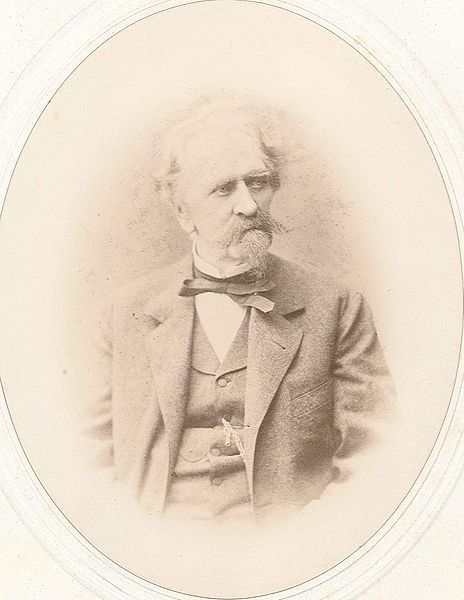

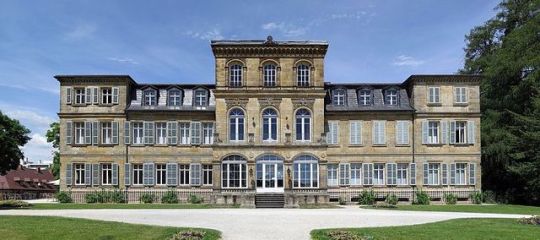
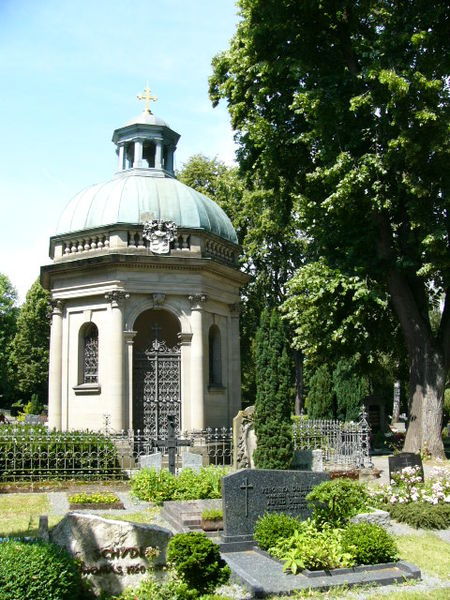


Das Schloss Fantaisie steht in Donndorf, fünf Kilometer westlich von Bayreuth. Erbaut wurde es als weitere Sommerresidenz (nach der Eremitage) für das Markgrafenpaar Friedrich und Wilhelmine von Brandenburg-Bayreuth.
Herzog Friedrich Wilhelm Alexander von Württemberg (* 20. Dezember 1804 in Riga; † 28. Oktober 1881 in Bayreuth) war der älteste Sohn des Herzogs Alexander Friedrich Karl von Württemberg und dessen Frau, der Prinzessin Antoinette (1779–1824), der zweiten Tochter von Herzog Franz von Sachsen-Coburg-Saalfeld. Sein Onkel war König Friedrich I. von Württemberg.
Herzog Alexander war wie sein Vater in den russischen Militärdienst eingetreten. 1828 war er beim Feldzug gegen das Osmanische Reich und 1831 gegen Polen beteiligt.
Er heiratete am 17. Oktober 1837 die katholische Prinzessin Marie Christine von Orléans (1813–1839), die zweite Tochter von Ludwig Philipp, dem König der Franzosen. Das einzige Kind dieser Ehe war der 1838 geborene Herzog Philipp von Württemberg, der die katholische Linie des Hauses Württemberg begründete.
Nach dem frühen Tod seiner Frau lebte Herzog Alexander in den Sommermonaten der kommenden Jahrzehnte im Schloss Fantaisie und verbrachte die Wintermonate in der fünf Kilometer entfernten Stadtwohnung in Bayreuth. Herzog Alexander verwaltete das Schloss und den zugehörigen Park in vorzüglicher Weise und erfreute sich bei der dortigen Bevölkerung großer Beliebtheit wegen seiner regen Teilnahme an Vereinsleben und wohltätigen Stiftungen für Arme und Kranke.
Er erbaute ein dem Schloss benachbartes Hotel Fantaisie, in dem im Laufe der Jahre berühmte Zeitgenossen wie 1866 König Ludwig II. von Bayern oder 1872 Richard Wagner logierten. Am 11. Juni 1868 heiratete der Herzog ein zweites Mal in morganatischer Ehe seine Haushälterin Katharine Amalie Pfennigkaufer (* 31. Juli 1829; † 31. März 1915), später Frau von Meyernberg, sehr zum Missfallen seines Sohnes Philipp.
Eine morganatische Heirat erfolgte oft mit der Absicht des Mannes, die bestehende Liebesbeziehung zu einer Mätresse als öffentlich anerkanntes Verhältnis zu legitimieren.
Dessen Großmutter sammelten während einer fast einjährigen Italienreise Eindrücke, die sie in Schloss Fantaisie umsetzten. Wilhelmine konnte den Baubeginn nicht mehr miterleben, sie starb 1758 im Alter von 49 Jahren. Friedrich begann 1761 mit dem Bau. Auch er konnte die Fertigstellung nicht miterleben. Er starb 1763 im Alter von 51 Jahren in Bayreuth.
Die Tochter des Markgrafenpaares, Prinzessin Friederike, erbte den Besitz 1763. Von ihr stammt der Name Fantaisie. Sie ließ das Schloss bis 1765 von Johann Jakob Spindler errichten. Es beherbergt das Spindler-Kabinett, eine Intarsienarbeit der Gebrüder Johann Friedrich und Heinrich Wilhelm Spindler in einer originalgetreuen Nachbildung des Originals, das sich im Bayerischen Nationalmuseum in München befindet.
Nach Friederikes Tod 1780 wurden Schloss und Park veräußert. 1792 erwarb ihre Cousine Friederike Dorothea Sophia von Brandenburg-Schwedt (1736–1798) den Besitz. Gemeinsam mit ihrem Mann, Herzog Friedrich Eugen von Württemberg (1732–1797), ließ sie den Park anglisieren. Ihr Enkel Alexander Friedrich Wilhelm (1804–1881) stockte das Schloss auf und ließ die Gartenstaffagen im Zeitgeschmack erneuern.
Aufgrund dieser späteren Umbauten hat sich nur sehr wenig vom ursprünglichen Schloss erhalten. Der bestechende Schlosspark ist geprägt von Elementen aus den Stilphasen Rokoko, Empfindsamkeit, Romantik und Historismus. Im Schlossgebäude wurde im Jahr 2000 das erste Gartenkunstmuseum Deutschlands eingerichtet. Seit einigen Jahren wird der Park in seinen ursprünglichen Zustand zurückversetzt. So wurden die Südterrassen, die zum See hin zeigen, wieder mit Weinstöcken bepflanzt, das Labyrinth wurde wieder angelegt und die Wasserkaskaden mit Sandsteinmuscheln und Fabelwesen instand gesetzt.
Herzog Philipp Alexander Maria Ernst von Württemberg (* 30. Juli 1838 in Neuilly-sur-Seine; † 11. Oktober 1917 in Stuttgart) war als Sohn des Herzogs Alexander Friedrich Wilhelm von Württemberg und Marie Christine von Orléans ein Mitglied des Hauses Württemberg.
Da die Mutter starb, als der Sohn erst sechs Monate alt war, brachte man ihn an den Pariser Hof, wo er von seinen Großeltern König Ludwig Philipp von Frankreich und Königin Marie Amélie erzogen wurde. Obwohl das Haus Württemberg und damit auch der Vater protestantisch waren, wurde der Junge katholisch getauft, weswegen das Haus Württemberg heute katholisch ist. Im Jahr 1848 floh die königliche Familie aufgrund der Revolution aus Paris. Der Junge kehrte zu seinem Vater zurück und bewohnte mit ihm Schloss Fantaisie in Bayreuth.
Herzog Philipp bewohnte mit seiner Familie das Prinzenpalais in Stuttgart, nachdem er 1905 den Strudelhof in Wien verkauft hatte. Im Alter von 79 Jahren verstarb der Herzog in Stuttgart und wurde in Ludwigsburg beigesetzt; im Jahr 1927 ließ der Sohn Herzog Albrecht den Sarg in die neu erbaute Familiengruft an der Schloss- und Pfarrkirche St. Michael in Altshausen überführen. Herzog Philipp ist Stammvater des heutigen Hauses Württemberg.
Gemäß den Ordensstatuten wurde ihm mit dem vierzehnten Lebensjahr das Großkreuz des Ordens der Württembergischen Krone verliehen.
Herzog Philipp heiratete am 18. Januar 1865 in der Kammerkapelle der Wiener Hofburg Erzherzogin Marie Therese von Österreich (1845–1927), Tochter von Feldmarschall Erzherzog Albrecht von Österreich-Teschen. Das Paar hatte sechs Kinder:
Albrecht (1865–1939)
Marie Amelie von Württemberg (1865–1883), jüngere Zwillingsschwester Albrechts, starb an der Tuberkulose
Maria Isabella (1871–1904) ∞ Johann Georg Prinz von Sachsen (1869–1938)
Robert (1873–1947) ∞ Maria Immaculata von Österreich (1878–1968), Tochter von Erzherzog Karl Salvator von Toskana(1839–1892)
Ulrich (1877–1944)
0 notes